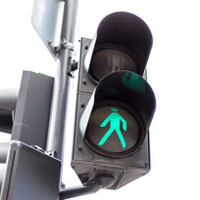City Streets Can be Hazardous for Cyclists and Pedestrians
March 12, 2019 More people who live and work in cities across the country are choosing to walk or ride their bike to work. Not only is it a great form of exercise, but it saves money and is better for the environment.
More people who live and work in cities across the country are choosing to walk or ride their bike to work. Not only is it a great form of exercise, but it saves money and is better for the environment.
Unfortunately, this trend has also resulted in an increase in pedestrian and cyclist fatalities.
In fact, since 2010, the number of cyclist fatalities has gone up by 25 percent, and there has been a 45 percent increase in the number of pedestrian fatalities. These statistics are surprising, given the fact that the number of traffic fatalities as a whole has declined.
However, while many U.S. cities are encouraging their residents to walk or use their bicycles, more proactive steps need to be taken to make the roads safer for cyclists and pedestrians overall.
What Makes City Streets Dangerous for Cyclists and Pedestrians?
Despite efforts to make cities more bike and pedestrian-friendly, oftentimes, the implementation of bike lanes, pedestrian zones, and other traffic calming measures can cause confusion.
In addition, even a relatively slow-moving vehicle can cause serious, often fatal injuries to a cyclist or pedestrian, even though a pedestrian is more likely to be fatally injured by a car traveling at 36 to 45 mph, compared to a car travelling between 26 to 30 mph.
Distracted driving also continues to be a major problem in this country, which can have fatal consequences if a motorist fails to notice a pedestrian crossing the street because they were checking a text rather than paying attention to the road.
The Vision Zero Strategy
In an effort to address this problem, many cities have committed to the Vision Zero strategy, which was first introduced in Sweden in 1997. The Vision Zero strategy is a multi-discipline partnership between engineers, local traffic planners, public health officials, and policymakers to employ a more proactive and well-rounded approach to safety.
Currently, there are at least 18 U.S. cities that have pledged to reach that goal by 2024, including Boston, Chicago, Los Angeles, New York, and Washington, D.C.
Some of the strategies that cities are using include reducing speed limits, improving intersections, and implementing more bicycle-friendly policies. A part of the Vision Zero approach includes getting car manufacturers to also consider reducing the height of a vehicles’ front bumper, which can make the car less physically threatening to pedestrians and cyclists in the event of an accident.
Cities will also need to continue to evaluate their infrastructures and develop new and effective initiatives, including those that address social and class differences, that will help reach the goal of zero traffic fatalities or serious injuries by 2024.
Ultimately, researchers believe that we need to reimagine the way we think about cities, seeing them as more cooperative shared spaces with streets that are safe for motorists, cyclists, and pedestrians alike.
Baltimore Car Accident Lawyers at LeViness, Tolzman & Hamilton Seek Justice for Victims of Bicycle and Pedestrian Accidents
If you or someone you know has been injured in a car accident while walking or riding a bike, you are urged to contact the Baltimore car accident lawyers at LeViness, Tolzman & Hamilton at your earliest convenience. We will investigate the events leading up to the accident and determine who is at fault. Our skilled legal team will protect your rights and secure the maximum financial compensation you deserve. To schedule a free, confidential consultation, call us today at 800-547-4LAW (4529) or contact us online.
Our offices are located in Baltimore, Columbia, Glen Burnie, and Towson, allowing us to represent car accident victims in Maryland, including those in Anne Arundel County, Baltimore County, Carroll County, Harford County, Howard County, Montgomery County, Maryland’s Western Counties, Prince George’s County, Queen Anne’s County, Southern Maryland, and the Eastern Shore, as well as the communities of Catonsville, Essex, Halethorpe, Middle River, Rosedale, Gwynn Oak, Brooklandville, Dundalk, Pikesville, Nottingham, Windsor Mill, Lutherville, Timonium, Sparrows Point, Ridgewood, and Elkridge.






